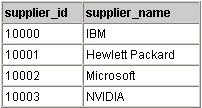SQL : Joins
Introduction:
A join is used to combine rows from multiple tables. A join is performed whenever two or more tables is listed in the FROM clause of an SQL statement.
There are different kinds of joins. Let's take a look at a few examples.
Inner Join (simple join)
Chances are, you've already written an SQL statement that uses an inner join. It is the most common type of join. Inner joins return all rows from multiple tables where the join condition is met.
For example
SELECT suppliers.supplier_id, suppliers.supplier_name, orders.order_dateFROM suppliers, ordersWHERE suppliers.supplier_id = orders.supplier_id;
A join is used to combine rows from multiple tables. A join is performed whenever two or more tables is listed in the FROM clause of an SQL statement.
There are different kinds of joins. Let's take a look at a few examples.
Inner Join (simple join)
Chances are, you've already written an SQL statement that uses an inner join. It is the most common type of join. Inner joins return all rows from multiple tables where the join condition is met.
For example
SELECT suppliers.supplier_id, suppliers.supplier_name, orders.order_dateFROM suppliers, ordersWHERE suppliers.supplier_id = orders.supplier_id;
This SQL statement would return all rows from the suppliers and orders tables where there is a matching supplier_id value in both the suppliers and orders tables.
Let's look at some data to explain how inner joins work:
Let's look at some data to explain how inner joins work:
We have a table called suppliers with two fields (supplier_id and supplier_ name).It contains the following data:

We have another table called orders with three fields (order_id, supplier_id, and order_date).It contains the following data:  If we run the SQL statement below:
If we run the SQL statement below:
SELECT suppliers.supplier_id, suppliers.supplier_name, orders.order_dateFROM suppliers, ordersWHERE suppliers.supplier_id = orders.supplier_id;
 If we run the SQL statement below:
If we run the SQL statement below:SELECT suppliers.supplier_id, suppliers.supplier_name, orders.order_dateFROM suppliers, ordersWHERE suppliers.supplier_id = orders.supplier_id;
Our result set would look like this:

The rows for Microsoft and NVIDIA from the supplier table would be omitted, since the supplier_id's 10002 and 10003 do not exist in both tables.
Outer Join
Another type of join is called an outer join. This type of join returns all rows from one table and only those rows from a secondary table where the joined fields are equal (join condition is met).
For example,
Another type of join is called an outer join. This type of join returns all rows from one table and only those rows from a secondary table where the joined fields are equal (join condition is met).
For example,
select suppliers.supplier_id, suppliers.supplier_name, orders.order_datefrom suppliers, orderswhere suppliers.supplier_id = orders.supplier_id(+);
This SQL statement would return all rows from the suppliers table and only those rows from the orders table where the joined fields are equal.
The (+) after the orders.supplier_id field indicates that, if a supplier_id value in the suppliers table does not exist in the orders table, all fields in the orders table will display asin the result set.
The (+) after the orders.supplier_id field indicates that, if a supplier_id value in the suppliers table does not exist in the orders table, all fields in the orders table will display as
The above SQL statement could also be written as follows:
select suppliers.supplier_id, suppliers.supplier_name, orders.order_datefrom suppliers, orderswhere orders.supplier_id(+) = suppliers.supplier_id
Let's look at some data to explain how outer joins work:
We have a table called suppliers with two fields (supplier_id and name).It contains the following data:

If we run the SQL statement below:
select suppliers.supplier_id, suppliers.supplier_name, orders.order_datefrom suppliers, orderswhere suppliers.supplier_id = orders.supplier_id(+);
Our result set would look like this:

The rows for Microsoft and NVIDIA would be included because an outer join was used. However, you will notice that the order_date field for those records contains a

Comments
Post a Comment